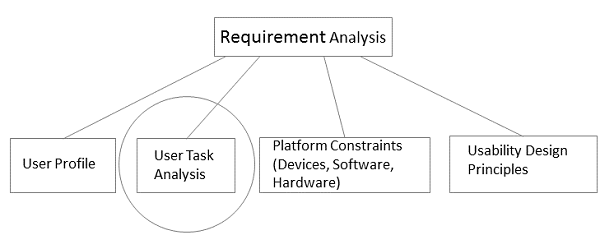
- Human Computer Interface Tutorial
- HCI Home
- HCI Introduction
- Guidelines in HCI
- Interactive System Design
- Interactive Devices
- Design Process & Task Analysis
- Dialog Design
- Information Search & Visualization
- Object Oriented Programming
- HCI Summary
- HCI - Resources
- HCI - Quick Guide
- HCI - Useful Resources
- HCI - Discussion
Design Process & Task Analysis
HCI Design
HCI design is considered as a problem solving process that has components like planned usage, target area, resources, cost, and viability. It decides on the requirement of product similarities to balance trade-offs.
The following points are the four basic activities of interaction design −
- Identifying requirements
- Building alternative designs
- Developing interactive versions of the designs
- Evaluating designs
Three principles for user-centered approach are −
- Early focus on users and tasks
- Empirical Measurement
- Iterative Design
Design Methodologies
Various methodologies have materialized since the inception that outline the techniques for human–computer interaction. Following are few design methodologies −
Activity Theory − This is an HCI method that describes the framework where the human-computer interactions take place. Activity theory provides reasoning, analytical tools and interaction designs.
User-Centered Design − It provides users the center-stage in designing where they get the opportunity to work with designers and technical practitioners.
Principles of User Interface Design − Tolerance, simplicity, visibility, affordance, consistency, structure and feedback are the seven principles used in interface designing.
Value Sensitive Design − This method is used for developing technology and includes three types of studies − conceptual, empirical and technical.
Conceptual investigations works towards understanding the values of the investors who use technology.
Empirical investigations are qualitative or quantitative design research studies that shows the designer’s understanding of the users’ values.
Technical investigations contain the use of technologies and designs in the conceptual and empirical investigations.
Participatory Design
Participatory design process involves all stakeholders in the design process, so that the end result meets the needs they are desiring. This design is used in various areas such as software design, architecture, landscape architecture, product design, sustainability, graphic design, planning, urban design, and even medicine.
Participatory design is not a style, but focus on processes and procedures of designing. It is seen as a way of removing design accountability and origination by designers.
Task Analysis
Task Analysis plays an important part in User Requirements Analysis.

Task analysis is the procedure to learn the users and abstract frameworks, the patterns used in workflows, and the chronological implementation of interaction with the GUI. It analyzes the ways in which the user partitions the tasks and sequence them.
What is a TASK?
Human actions that contributes to a useful objective, aiming at the system, is a task. Task analysis defines performance of users, not computers.
Hierarchical Task Analysis
Hierarchical Task Analysis is the procedure of disintegrating tasks into subtasks that could be analyzed using the logical sequence for execution. This would help in achieving the goal in the best possible way.
"A hierarchy is an organization of elements that, according to prerequisite relationships, describes the path of experiences a learner must take to achieve any single behavior that appears higher in the hierarchy. (Seels & Glasgow, 1990, p. 94)".
Techniques for Analysis
Task decomposition − Splitting tasks into sub-tasks and in sequence.
Knowledge-based techniques − Any instructions that users need to know.
‘User’ is always the beginning point for a task.
Ethnography − Observation of users’ behavior in the use context.
Protocol analysis − Observation and documentation of actions of the user. This is achieved by authenticating the user’s thinking. The user is made to think aloud so that the user’s mental logic can be understood.
Engineering Task Models
Unlike Hierarchical Task Analysis, Engineering Task Models can be specified formally and are more useful.
Characteristics of Engineering Task Models
Engineering task models have flexible notations, which describes the possible activities clearly.
They have organized approaches to support the requirement, analysis, and use of task models in the design.
They support the recycle of in-condition design solutions to problems that happen throughout applications.
Finally, they let the automatic tools accessible to support the different phases of the design cycle.
ConcurTaskTree (CTT)
CTT is an engineering methodology used for modeling a task and consists of tasks and operators. Operators in CTT are used to portray chronological associations between tasks. Following are the key features of a CTT −
- Focus on actions that users wish to accomplish.
- Hierarchical structure.
- Graphical syntax.
- Rich set of sequential operators.